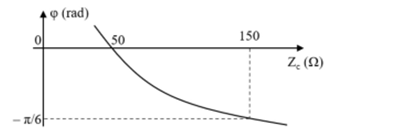Đặt điện áp xoay chiều (V) (
Lưu về Facebook:

MỤC LỤC
Câu hỏi:
Đặt điện áp xoay chiều (V) ( và không đổi) vào hai đầu một đoạn mạch mắc nối tiếp gồm điện trở R, cuộn cảm thuần có hệ số tự cảm L và tụ điện có điện dung C thay đổi được. Gọi là cường độ dòng điện tức thời qua mạch, là độ lệch pha giữa u và i. Đồ thị biểu diễn sự phụ thuộc của theo dung kháng của tụ điện khi C thay đổi như hình vẽ. Khi thì nhận giá trị

Đáp án án đúng là: C
Lời giải chi tiết:
Phương pháp:
+ Đọc đồ thị
+ Sử dụng biểu thức:
Cách giải:
Từ đồ thị, ta có:
+ Khi thì Xảy ra cộng hưởng điện
+ Khi thì
Ta có:
+ Khi thì
Chọn C.
Xem thêm các bài tiếp theo bên dưới
- Cho đoạn mạch gồm 3 phần tử R, L, C mắc nối tiếp, trong đó cuộn dây th
- Một vật có khối lượng 100 g dao động điều hòa với tần số 5 Hz và biên
- Nếu giữ cho các thông số khác không đổi thì tần số dao động của sóng đ
- Một mạch dao động gồm tụ điện có điện dung C = 10nF, cuộn cảm thuần có
- Phát biểu nào sau đây về tính chất của sóng điện từ là không đúng? A.